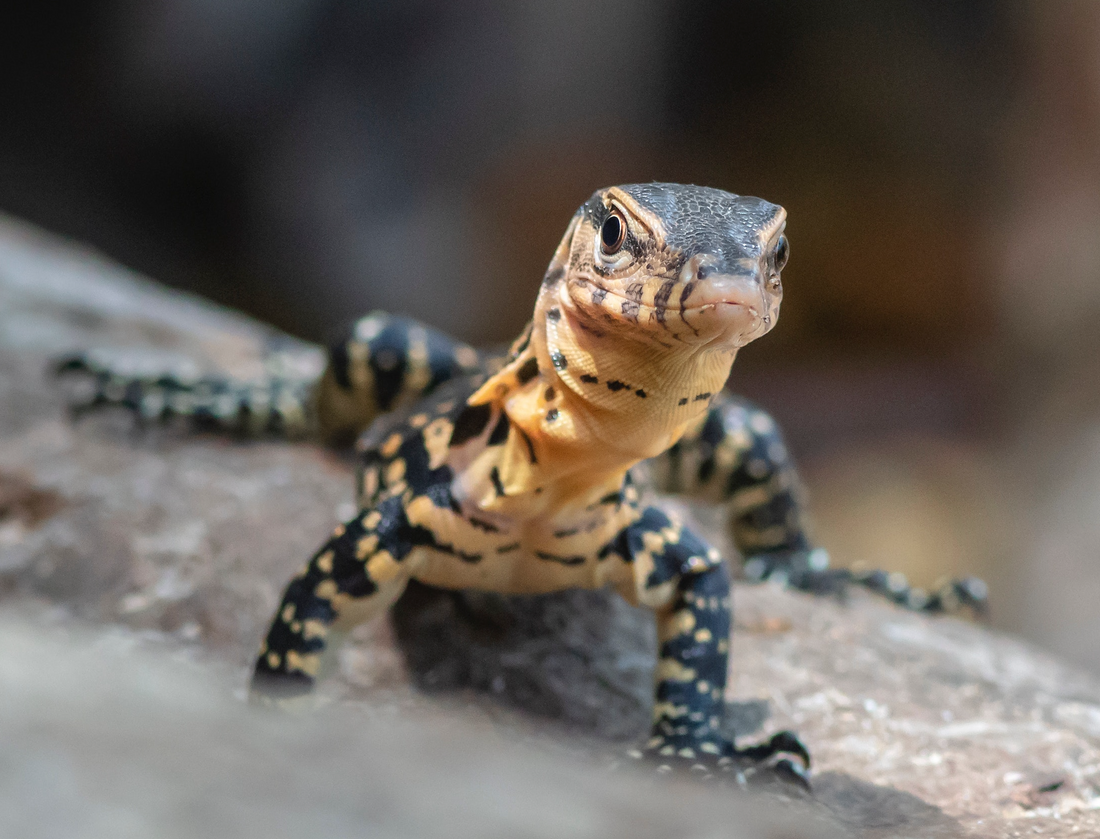Monitor lizards are one of the most popular varieties in the reptile hobby. Thanks to their wide range of sizes, even those who don’t have a full room to dedicate to a single scaly friend can likely find a monitor that suits their current space. However, there’s a lot of debate about what to feed a monitor lizard to prevent some of the most common problems this species faces, including fatty liver disease. Also called hepatic lipidosis, fatty liver disease is the leading cause of medical complications that lead to death in captive-kept monitor lizards.
Reptilinks wants to support the proper care of all reptiles fed on our products, which is why the company has just launched its Bayou blend. In order to understand why this is a great option for monitors too, you’ll need to first explore what monitor lizards eat in the wild and how much of that diet a keeper can safely (and feasibly) replicate in a captive environment.
What Do Monitor Lizards Eat in the Wild?
Monitors come in all shapes and sizes, so making one blanket statement about what they eat isn’t possible. A fully aquatic monitor will naturally consume prey that terrestrial reptiles might not have access to. That being said, there is significant overlap among the diets of monitors across the world.
What scientists know for sure is that no monitor species subsists entirely on vegetation. Even those that primarily rely on fruits like the Northern Sierra Madre Forest monitor will still snack on snails and other invertebrates. An omnivore diet benefits most monitors, and many of the common variants kept by hobbyists lean even more heavily toward carnivorous menus supplemented with insects and some vegetation.
The biggest element in a monitor’s wild diet is variety. These are skillful predators that hunt whatever they can find—or for those that eat fruits, they forage extensively across their natural range. Therefore, providing a breadth of food sources is critical for proper enrichment and nutrition in any captive monitor lizard. This ensures that your monitor receives a spectrum of minerals, vitamins, and other important building blocks for a healthy body and mind.
What Can Keepers Replicate in Captivity?
Many types of monitors rely on food items that keepers can’t—or don’t want to—replicate in a captive environment, such as carrion, termites, and turtles. However, because monitors thrive on such a varied diet, many types of vertebrate and invertebrate specimens make good feeders.
While most people will rely on frozen-thawed mice, rats, rabbits, chicks, and even guinea pigs as a staple for their monitors, Reptilinks encourages an even more varied array of meals. Most monitors are more insectivorous than a captive diet would indicate, and feeding dubia/discoid roaches, earthworms, grasshoppers, mealworms, snails, and black soldier fly larvae can add critical nutrients that your monitor needs.
Don’t forget that a monitor’s meals often include aquatic or semi-aquatic prey as well. Frogs, crustaceans, and small fish are commonly left out of a captive monitor’s diet, which is why Reptilinks created its Bayou blend. The company strives to make these rarer ingredients simple to feed so that your monitor receives the balanced diet that it needs.
If you choose to source your own invertebrate or aquatic prey, be sure to do your research. Wild-caught insects can carry a heavy parasite load, as wild-caught snails (even from your own garden).
Feeding with Caution
Feeding a monitor lizard presents dozens of opportunities for unique and enriching meals, but there are some things to keep in mind. One of the most common challenges in monitor keeping, as mentioned previously, is the prevalence of fatty liver disease. This has a lot to do with a monitor’s weight, so be sure that your lizard is getting enough exercise and that you’re enforcing a strict enough period in between feedings. An exercised lizard will be fully utilizing its meals for energy, keeping fat accumulation away from the liver.
Alongside proper exercise is an appropriate environment. While each monitor species is different, maintaining a hot enough basking spot and ambient temperatures ensures that your monitor can properly digest its meals and fully utilize the nutrients within. Look at the native range your monitor comes from to determine the temperatures that it should be exposed to in its enclosure. Remember—basking spots work best when they provide belly heat from below so that your monitor can warm its stomach directly. Tiles, rocks, and even logs that can absorb some heat from the basking spot and radiate it into the lizard from below as it basks are preferrable over simply having the basking spot shine into the dirt or substrate.
Another thing to keep in mind is the type of fish you feed. Many fish contain high levels of thiaminase. Think of thiaminase as the “opposite” of vitamin B1 (thiamin). When thiaminase is present, it prevents the absorption of thiamin in the body. Thus, feeding a lot of prey items high in thiaminase can prevent your reptile from getting the B vitamins it needs to stay healthy. Anchovies, goldfish, and smelt (which are all simple to acquire) are some of the types of fish that have thiaminase. However, there are dozens of excellent fish options like silversides, salmon, cod, trout, and tilapia, and even the occasional thiaminase-rich fish is not a problem. It all comes back to offering a robust variety of meals.
Reptilinks uses reputably sourced whole crawfish and bullfrog legs in our Bayou blend to provide the aquatic prey that monitors find in the wild. Our links also contain a mix of hisser roaches, grasshoppers, crickets, and superworms to fulfill the insectivorous needs of most monitors without centering every meal around a single prey type. Reptilinks provides links with or without fruits and vegetables, so you can decide which type suits your monitor best based on how much of this foliage your species naturally consumes in the wild.

